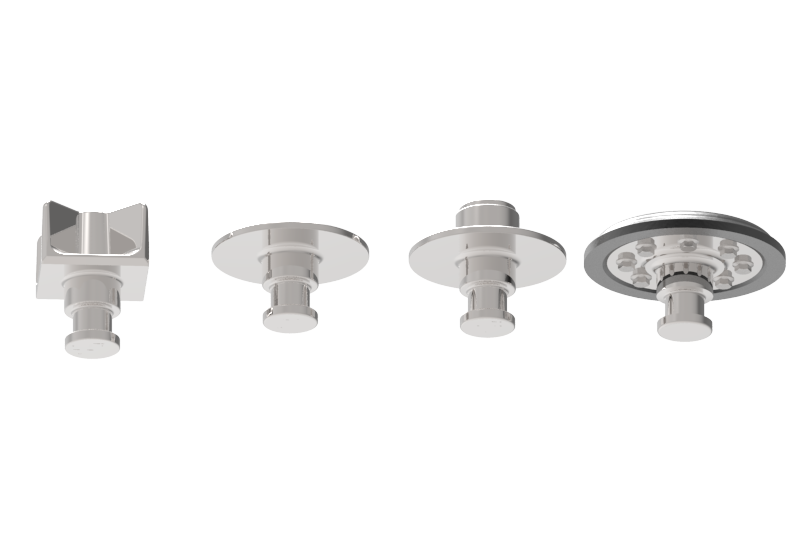What is a Kingpin on a Semi?
by JOST International | Oct 11, 2022 | Trailers Kingpins

Whether you’re new to coupling trailers or you’re just trying to get a handle on all of the technical part names, the JOST team is here to provide all the information you need around fifth wheels and industrial transportation.
In this article, we’re discussing the basics of kingpins for semi trucks. Here’s everything you need to know about what a kingpin is and what it does.
What is a Kingpin?
Frequently referred to as the “pivot point between the tractor and semi-trailer,” the kingpin is the part used to connect a semi-tractor and a semi-trailer. A kingpin may resemble any of the above images but always shares a few key features:
- A welded side. One side of the kingpin is always welded to the semi-trailer. This is why kingpins are often considered a “trailer solution” rather than a “truck solution.” They are always fixed to the trailer and then coupled with the tractor using a fifth wheel coupling device.
- A tapered section. Every kingpin has a tapered section that is narrower in width than the sections above and below it. This is where the fifth wheel locks around the kingpin to provide a secure coupling. By making the areas above and below the tapered area wider, manufacturers ensure another layer of protection, minimizing the potential that a kingpin could slip out of a fifth wheel’s coupling mechanism.
What Does a Kingpin Do?
This small but mighty part comes in a variety of shapes and sizes, but works to do one thing: connect the semi-truck and trailer.
In addition to that primary function, a kingpin is also responsible (in partnership with the larger fifth wheel) for the steering and handling of the coupled rig. When properly coupled, the kingpin keeps the trailer and tractor together while allowing the tractor to turn and pivot around its fixed point, ensuring semi trucks are able to transport product with ease.
What Should I Look For in a Good Kingpin?
If you’re in the market for a new kingpin, you might be wondering how you decide from all the different kingpin types and manufacturers. Here are 3 key things to look for when purchasing a kingpin you can trust to keep you safe for years to come.
01. Durability
A kingpin is only as good as its lifespan. This is an integral component for any rig, and should the kingpin fail, your trailer cannot move. That’s why it’s important to look for a kingpin with proven durability. To assess this, evaluate:
- Manufacturing materials. What is the kingpin made out of? A kingpin made from high-quality steel is likely to last significantly longer than a kingpin manufactured with poor-quality materials.
- Manufacturing methods. We’ll talk more about manufacturing requirements and standards below, but how a product is manufactured can tell you a lot about how it will perform. Choose kingpins from manufacturers with safe, reliable manufacturing standards and safety requirements.
- Manufacturer standards and warranties. Does the manufacturer stand behind its product with a warranty or stringent manufacturing standards? If not, you may have a problem finding a kingpin that can stand up to long hours of wear and tear on the road.
02. Safety
Perhaps the most important feature of any kingpin is its ability to keep the operator and the rig safe. Choose kingpins from reputable manufacturers with a long track record of safe manufacturing practices. Quality manufacturers will be happy to provide you with the information you need to verify the safety of their products.
03. Local Standard Compliance
Every trailer OEM has its own international standards. Your trailer must meet those standards to ensure safe, compliant hauling in your area. To ensure you’re in compliance, first find a manufacturer that produces kingpins according to your local standards, and then verify their compliance. A great manufacturer will prove with data how their kingpins meet established performance requirements.
If you’re not sure what standards to look to, the most popular standard compliance requirements in North America include:
- SAE (Society of Automotive Engineers) specification for dimensions, materials, and installation).
- AAR (Association of American Railroads) specification for SAE dimensions and greater installation, structure, and material strength/wear specifications.
- TMC (American Trucking Association — Technology and Maintenance Council) RMP-750 – kingpin and upper coupler inspection for deformation and wear replacement standards.
Safe hauling starts with safe parts. And no one manufactures for safety better than JOST international. If you’re looking for a superior kingpin from an industry-leading manufacturer, JOST can help. Our kingpins meet or exceed international standards for OEMs and fleet use in North America and internationally.
